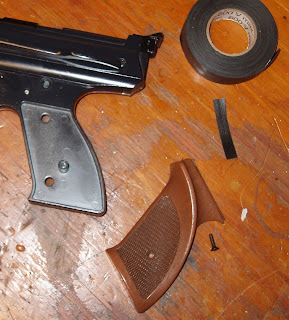I'd never heard of EIG but looking at the picture and description it seemed to be a Taiyo Juki CO2 powered rifle. The Buy It Now price was quite cheap so I snapped it up. Looking in The Blue Book of Airguns
As to why the title of the auction said EIG and not Taiyo Juki? The rifle itself is not marked Taiyo Juki or Junior anywhere, just EIG Cal..177 Made in Japan. So what was EIG? EIG was EIG Cutlery, an importer of knives and firearms based down in Florida. The same EIG is the last name of the then owner, Saul Eig. There's tidbits of information around the web about EIG but nothing I could find about their airgun imports.
As for Taiyo Juki? There's a bit more information as their parent company, Miroku Corp. is still in business, but they don't have any information about their airgun offerings (at least in english) on their firearms division webpage. I have seen other models of Taiyo Juki mentioned on the various airgun forums but nothing much on the Junior.

The rifle. I really need to set up a method for photgraphing whole rifles that's more aesthetically pleasing.

EIG CAL..177 JAPAN

The serial number?

The cocking knob (just as with the Crosman 180, it cocks separately from loading.)

The bolt.

The front sight is milled from steel.

It has a flow through bolt nose. The gun was full of sticky grease for some reason.

Since it likely needed new seals and was greasy and dirty I started to strip it down.

Rear trigger guard wood screw, front a machine screw into the action.

The trigger spring springs up.

And the stock comes off. Just the one screw holds the stock to the action.

The CO2 tube cap. That o-ring looks pristine.

The barrel band is coarse plastic and seems shoddily made compared to the rest of the rifle.

An extremely simple trigger and sear.

One screw from the bottom into the cocking assembly.

removed.

It's the short screw, if you're keeping track at home.

Flipped right side up, another screw through the barrel into the cocking assembly.

Which is the long screw.

The assembly comes out easily.

Greasy. The assembly seems to be of good quality.

I tried to remove that screw but the rod down the center just spins. No desire to destroy anything so I left it alone.

There's a power adjuster screw.

And the hammer has a small extension that actually hits the valve stem.
More to come...




































